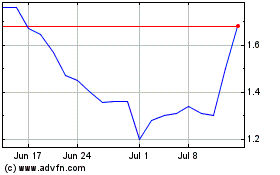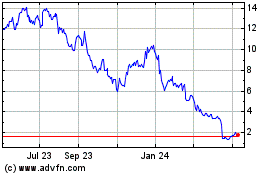Pacific Biosciences Highlights Increased Focus on Human Genome Research at AGBT 2014; Releasing 54x Coverage Human Genome Dat...
February 10 2014 - 7:30AM

Pacific Biosciences of California, Inc. (Nasdaq:PACB), provider of
the PacBio® RS II DNA Sequencing System, announced that its Single
Molecule, Real-Time (SMRT®) Sequencing technology will be featured
in nine podium presentations and 29 posters at this year's Advances
in Genome Biology and Technology (AGBT) meeting, with more than
half presenting research on human and other complex genomes. In
addition, on Wednesday the company will publicly release a
long-read dataset for generating the first de novo human genome
assembly from PacBio-only sequence reads.
"Recent performance increases on the PacBio RS II
— notably substantial improvements in throughput
— are allowing scientists to approach much larger
genome sequencing projects. The list of recent accomplishments
using SMRT Sequencing includes agriculturally valuable plants such
as spinach, model organisms such as Drosophila and Arabidopsis, and
now, very high-quality work on human genomes," said Michael
Hunkapiller, Chief Executive Officer of Pacific Biosciences. "We
are delighted with the diversity of applications that will be
showcased by our customers this year at AGBT, including
unprecedented work on the human genome."
Pacific Biosciences used its P5-C3 sequencing chemistry to
generate ~54x coverage on a well-studied human haploid cell line
(CHM1htert), which is being utilized as part of a National
Institutes of Health project to sequence and assemble an alternate
reference genome (the so-called "platinum genome"), an effort led
by Rick Wilson from the Washington University in St. Louis and Evan
Eichler from the University of Washington in collaboration with
investigators from the National Center for Biotechnology
Information (NCBI).
The human genome dataset is being deposited in the public domain
to offer the bioinformatics and scientific communities an
additional dataset to accelerate the understanding of genome-wide
variation at all genome size scales, and to improve assembly
techniques. To demonstrate the value of using PacBio long-read data
to create de novo assemblies of human genomes following the general
Hierarchical Genome Assembly Process (HGAP), Pacific Biosciences
collaborated with Google to leverage the Google Cloud Platform for
the most computationally intensive part of the assembly pipeline.
In a single day, the pipeline executed 405,000 CPU hours to align
the long reads to each other. These data were transferred back to
the company to complete the assembly process, which resulted in a
3.25 Gb assembly with a contig N50 of 4.38 Mb, and with the longest
contig being 44 Mb. This represents over an order of magnitude
better N50 than the most recent reference-guided assembly using
Illumina® sequencing and BAC-clone finishing on the same sample,
which had a total assembly size of 2.83 Gb and a contig N50 of 144
kb.
Deanna Church, currently of Personalis, Inc. and previously at
NCBI as a founding member of the Genome Reference Consortium,
commented: "The human reference assembly is central to all modern
sequence analysis; therefore it is critical that the assembly is of
the highest possible quality. The Genome Reference Consortium has
been working towards this goal for years, and the CHM1 resource was
invaluable for some of the improvements in GRCh38 (the
latest human reference version of released by NCBI). However,
even the latest GRCh38 assembly has regions that need improvement
and additional sequencing technologies like SMRT Sequencing will
clearly be necessary to continue improving the reference
assembly. Personalis has also worked to develop advanced human
reference versions and applauds new accomplishments by others in
this area."
PacBio's 54x data initiative was a follow-on project from the
October 2013 release of a 10x coverage dataset of a human genome
for detecting structural variation relative to the human reference
genome. Human genomes harbor many potentially medically
relevant structural variations, which are often difficult or
impossible to resolve using short-read technologies. To date, most
studies on human variation consist of resequencing and comparing to
a human reference genome. However, in order to comprehensively
assess genetic variation between humans, de novo assemblies and
subsequent comparison between genomes are desirable.
The unique value of this dataset will be described in several
presentations at AGBT, including a talk by Gene Myers of the Max
Planck Institute for Molecular Cell Biology and Genetics titled "A
De Novo Whole Genome Shotgun Assembler for Noisy Long Read Data."
The data will also be discussed in a presentation by PacBio's
Senior Director of Bioinformatics Jason Chin titled "String Graph
Assembly For Diploid Genomes With Long Reads," and in a company
workshop on Friday hosted by Chief Scientific Officer Jonas
Korlach.
The human genome dataset will be summarized and accessible via
the PacBio blog on the morning of Wednesday, February 12. More
information about PacBio-related activities at AGBT 2014 is
available at www.pacb.com/agbt.
About the PacBio RS II and SMRT Sequencing
Pacific Biosciences' Single Molecule, Real-Time (SMRT)
Sequencing technology achieves the industry's longest read lengths
and highest consensus accuracy,i,ii along with the least degree of
biasiii. These characteristics, combined with its ability to detect
many types of DNA base modifications (e.g., methylation) as
part of the sequencing process, mean the PacBio RS II provides a
window into critical biological processes and medically,
agriculturally, and industrially relevant genetic and genomic
variation that can only be revealed with SMRT Sequencing
technology.
About Pacific Biosciences Pacific Biosciences
of California, Inc. (Nasdaq:PACB) offers the PacBio® RS II DNA
Sequencing System to help scientists solve genetically complex
problems. Based on its novel Single Molecule, Real-Time (SMRT®)
technology, the company's products enable: targeted sequencing to
more comprehensively characterize genetic variations; de novo
genome assembly to more fully identify, annotate and decipher
genomic structures; and DNA base modification identification to
help characterize epigenetic regulation and DNA damage. By
providing access to information that was previously inaccessible,
Pacific Biosciences enables scientists to increase their
understanding of biological systems.
More information is available at: www.pacb.com.
i Koren et al., "Reducing assembly complexity of microbial
genomes with single-molecule sequencing." Genome Biology, 14:R10.1
(2013).
ii Chin et al., "Nonhybrid, finished microbial genome assemblies
from long-read SMRT sequencing data." Nature Methods, 10; 563-569
(2013).
iii Ross et al. Characterizing and measuring bias in sequence
data. Genome Biol 14: R51 (2013).
CONTACT: For Pacific Biosciences:
Media:
Nicole Litchfield
For Pacific Biosciences
415.793.6468
nicole@bioscribe.com
Investors:
Trevin Rard
Pacific Biosciences
650.521.8450
ir@pacificbiosciences.com
Pacific Biosciences of C... (NASDAQ:PACB)
Historical Stock Chart
From Mar 2024 to Apr 2024

Pacific Biosciences of C... (NASDAQ:PACB)
Historical Stock Chart
From Apr 2023 to Apr 2024
